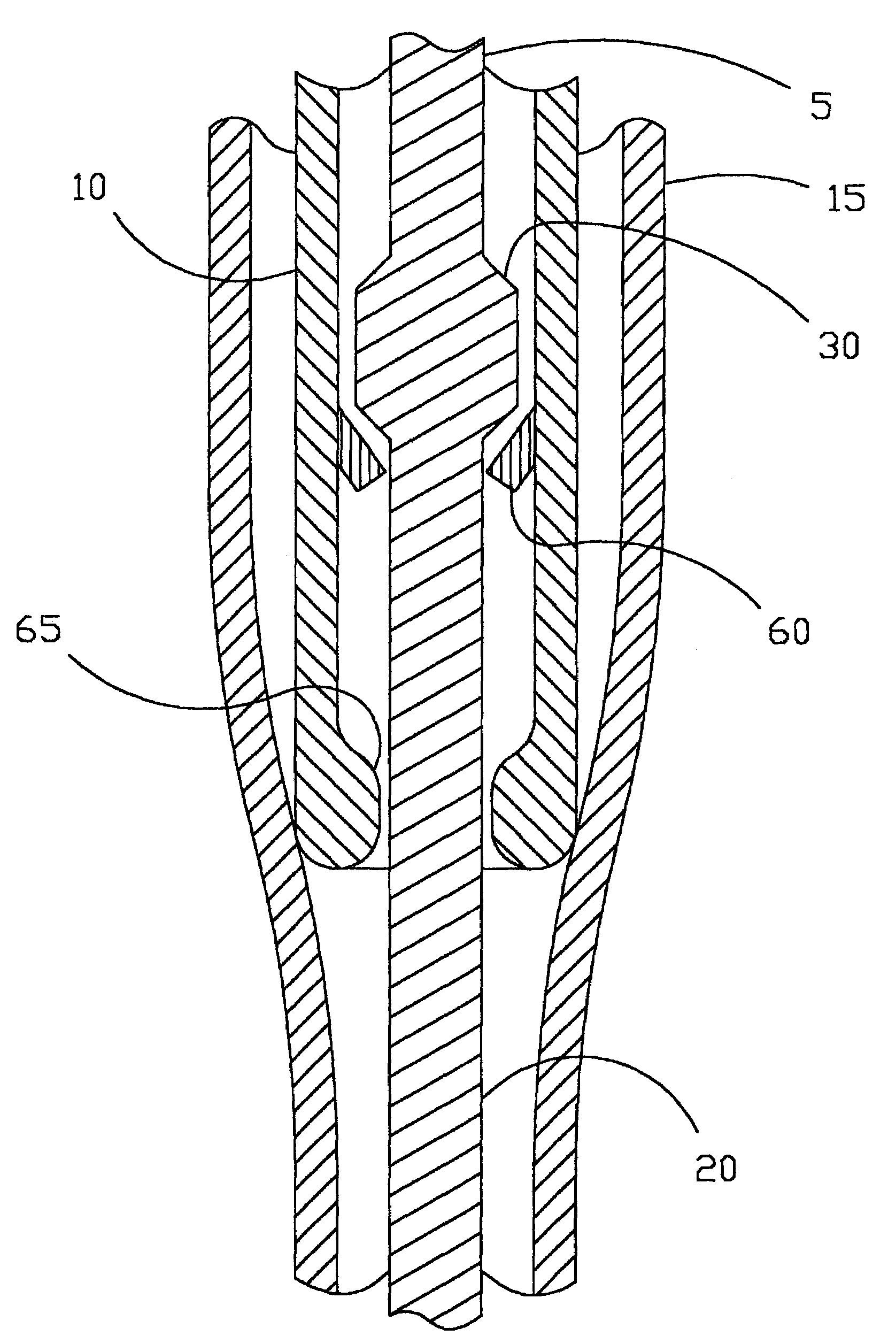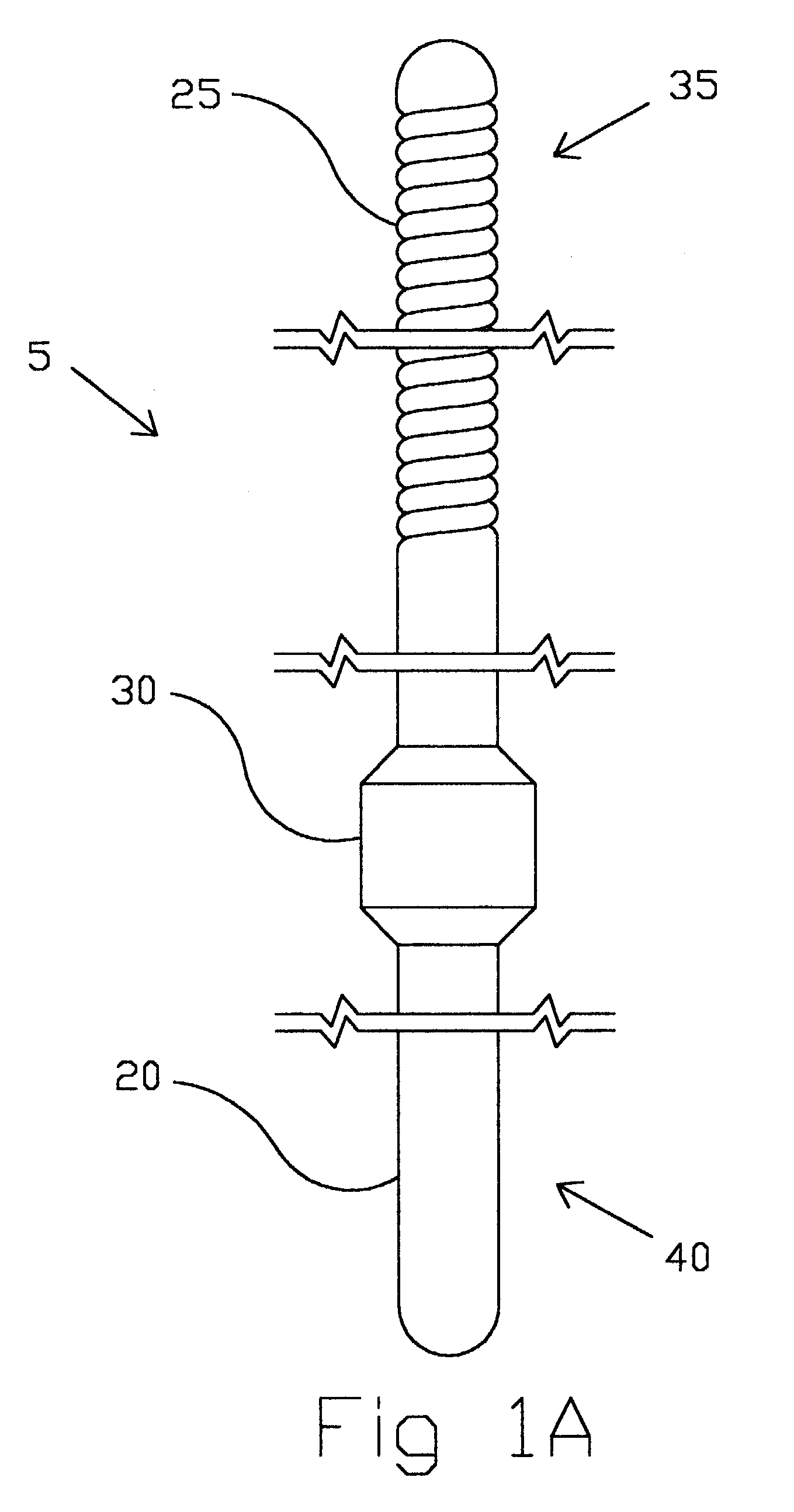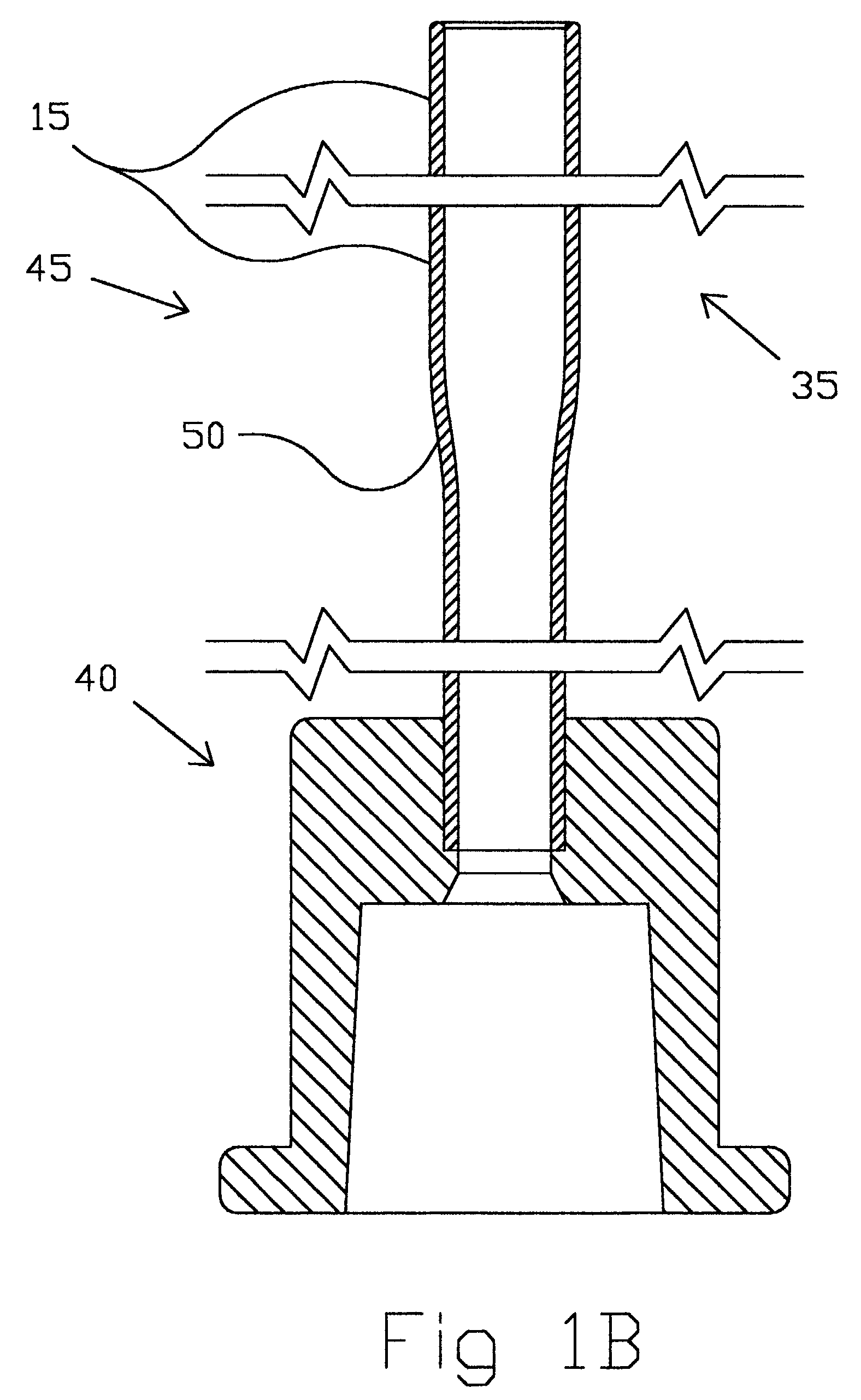[0012]The present
distal protection and
delivery system overcomes the disadvantages of other prior art distal protection devices. The present distal protection and delivery
system does not have the filter assembly attached directly to the guidewire during
insertion of the guidewire as it is with other prior art systems. Other prior art systems have attached their filter assembly directly to the guidewire and have compromised their ability to extend through difficult turns and reach some lesion sites due to the stiffness associated with the filter assembly and the introducer catheter. One component of the distal protection and delivery system of the present invention is a guidewire, another is a distal introducer, and another is a filter assembly. The guidewire component of the present invention can be formed with flexibility, trackability, and other structural features that are the same as other standard guidewires used for normal interventional procedures. Since the filter assembly is not permanently attached to the guidewire, the guidewire component of the present invention can extend through tortuous paths to reach and cross difficult lesions that require
interventional treatment. Once the guidewire component of the present invention has reached the site of the lesion, an introducer catheter carrying a filter assembly in a nondeployed state is able to follow over the body or
trunk of the guidewire to reach and cross the lesion. The filter assembly is then latched to a protrusion or
ferrule located on the guidewire by an ejector latch on the filter assembly. The filter assembly is therein positioned on the guidewire and can be deployed into the blood vessel by advancing the guidewire distally or retracting the introducer proximally. The filter assembly undergoes an expansion from a smaller
diameter of the introducer to the larger
diameter of the blood vessel. A porous
filter material located on a portion of the filter assembly serves to allow
blood flow through the filter but restricts the flow of embolic material from passing distal to the filter assembly.
[0013]In one embodiment a latching of the filter assembly to the guidewire results in maintaining the positioning of the filter assembly with respect to the guidewire during deployment of the filter assembly and any axial movement of the guidewire can result in some movement of the filter assembly. In another embodiment latching of the filter assembly to the guidewire is only temporary (as long as) while the filter assembly is not deployed from the distal introducer. The filter assembly of this embodiment is unlatched upon deployment and the guidewire is free to move distally with respect to the filter assembly without affecting positioning of the filter assembly. In yet another embodiment an ejector tube is used to eject the filter assembly out of the introducer rather than using an ejector latch. In this embodiment the guidewire is free to move with respect to the filter assembly following deployment of the filter assembly into the blood vessel.
[0015]With the filter assembly positioned in the blood vessel distal to the lesion the introducer can be removed from the blood vessel. An
angioplasty catheter can then be introduced over the guidewire of the present invention. The present invention is primarily intended for and can be positioned in a coronary
artery, a carotid
artery, other neurovascular
artery, a
peripheral artery of the leg, or any other blood vessel that requires
interventional treatment such as angioplasty and would benefit by a distal protection filter. Other therapeutic and diagnostic devices can also be advanced over the guidewire of the present invention such as
stent delivery catheters, a therectomy catheters, thrombectomy catheters,
angiography catheters, and other interventional catheters. During the use of such interventional catheters emboli are often generated from the plaque and deposit found on the vessel wall. These emboli can drift downstream if a distal protection device of the present invention is not positioned to capture the emboli distal to the lesion. Such emboli can block distal
capillary beds and arterioles resulting in reduced tissue
perfusion distal to the lesion. The presence of the filter assembly of the present invention will capture this embolic debris and allow the filter and embolic debris to be removed using the introducer of the present invention. In addition to use in the blood vessels of the body, the present invention could also be used in other tubular vessels of the body such as those found in the
ureter, bladder,
gall bladder,
kidney, and other tubular vessels of the body.
[0017]The filter assembly of the present invention can have many conformations without changing the intent of the invention. In one embodiment the filter assembly is formed from Nitinol or other shape memory material support members that extend from a proximal band to a distal band that slidingly moves with respect to the guidewire. This embodiment of the filter assembly can be formed from a single shape memory or elastic
metal tubular member that has been slotted by
laser or other mechanical or chemical method to form the support members. Alternately, the filter assembly can be formed of wires made of an elastic or shape memory material that are attached to a proximal or distal band. The filter assembly is unable to escape distally from the guidewire due to a stop mechanism on the filter assembly that interfaces with a
locking mechanism on the guidewire. The porous
filter material is attached to the
distal portion of these support members which hold the
filter material outward against the vessel wall to prevent leakage of embolic debris around the perimeter of the filter or through the filter.
[0019]The distal protection and delivery system of the present invention can be operated as an over-the-wire system wherein the introducer catheter follows over a guidewire over substantially the entire length of the introducer catheter. In order to remove an over-the-wire introducer catheter while maintaining the position of the guidewire and filter assembly within the vessel distal to the lesion, an exchange length guidewire of the present invention of about 260-320 cm can be used. A long exchange length guidewire allows other over-the-wire therapeutic or diagnostic catheters to be placed over the guidewire and delivered to the site of the lesion and to remove them following their use. Alternately, an over-the-wire distal protection and delivery system having an over-the-wire introducer catheter containing the filter assembly can be initially loaded onto a shorter more standard length expandable guidewire of approximately 170-200 cm. This expandable guidewire can later be expanded if necessary to allow exchanges of over-the-wire catheters. The introducer and guidewire can be delivered percutaneously to
a site that is proximal to the
vascular lesion to be treated. For example, in treating a coronary lesion, the introducer and guidewire can be advanced through a
guide catheter to a position near the coronary
ostium. The guidewire can then be advanced across the lesion while the introducer catheter remains within the
guide catheter. The distal introducer containing the filter assembly is then advanced over the guidewire to a position distal to the lesion. Deployment of the filter assembly is the same as described earlier. The guidewire is retracted proximally to latch the ejector latch of the filter assembly with the ferrule or
locking mechanism located on the guidewire. The introducer is then withdrawn while maintaining the position of the guidewire to release the filter assembly and allow it to expand out to the
diameter of the blood vessel. In order to remove the over-the-wire introducer from the vasculature without moving the distal end of the guidewire, a proximal extension guidewire of the present invention is attached by crimping or other mechanism to the proximal end of the expandable guidewire. This forms the expandable guidewire into an exchange length guidewire. Other catheters can be introduced over the extended guidewire and advanced to the lesion and can be removed from the vasculature over this guidewire. Following completion of interventional treatment the introducer catheter is reintroduced into the blood vessel the filter assembly is retracted into the distal introducer either partly or completely in a manner such that the filter membrane containing the embolic debris is retained within the distal introducer. The distal introducer, filter assembly, and guidewire can be removed from the vasculature along with the embolic debris that has been collected in the filter assembly.
 Login to View More
Login to View More  Login to View More
Login to View More 


